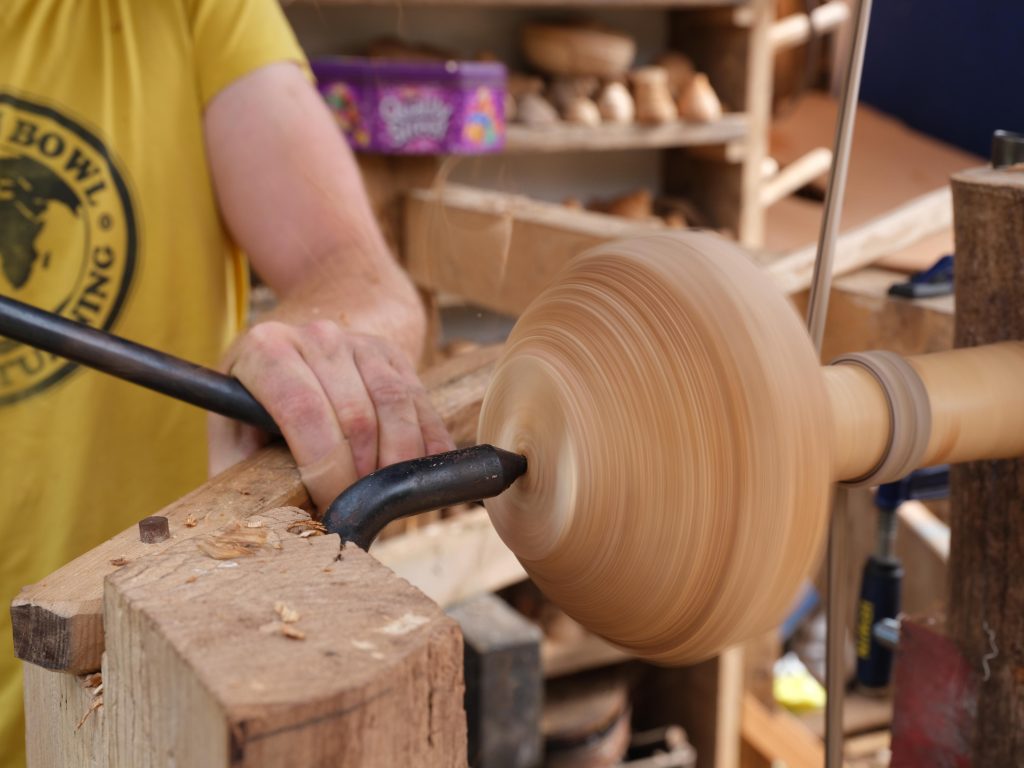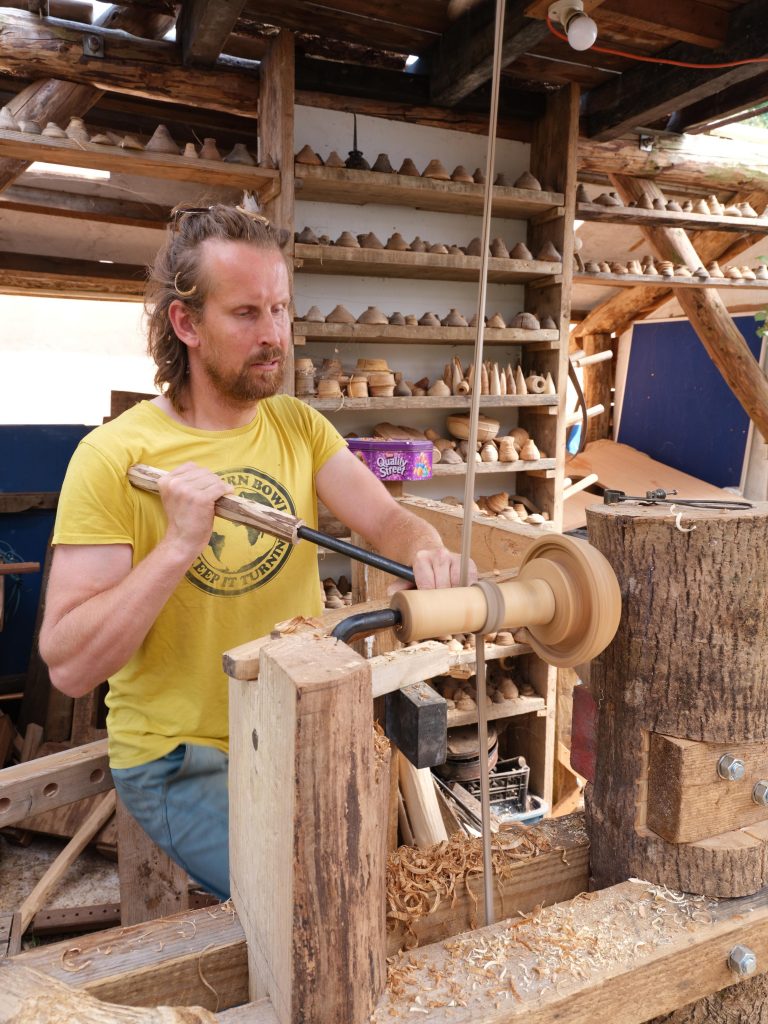Why I use a pole lathe
A question I often get asked at market by customers, and when speaking to other woodturners (who predominantly use power lathes) is ‘Why do I use a pole lathe?’. This article seeks to answer that question, acknowledging that it has changed over time and perhaps is still changing. In doing so, the blog also captures my journey into and through the craft to now.
Perhaps the best answer is the simplest and for that (like most things) we need to go back to the beginning… At the age of 22 I road-tripped around the USA with school-friends (the film ‘Roadtrip’ had just come out). At one point we found ourselves in Dollywood (a theme park run by and devoted to Dolly Parton and all things Country), and there was an old man with a big old white beard demonstrating the pole lathe. Whilst my friends went on rollercoasters I just sat and watched, mesmorized and captivated, by both his movements and the contraption he was turning on. It still feels like yesterday. So, my first answer is: ‘I feel contentment around the pole lathe.’

At the time, I felt that in today’s economy working on a pole lathe was folly, a hobby at best. At that stage I was not ready to break free from the self-imposed expectations of a society that values success based on take-home pay each year and occasional promotions. I spent ten years as a software engineer, albeit with a 15month break cycling down South America. That trip taught me that the poorest in society were some of the most generous and genuinely happy people. In hindsight, this realisation definitely allowed me re-assess what success meant to me.
In 2017 I quit my engineering job for good and moved to Bristol. It was during this time that I watched a Mastercrafts episode (on youtube) which introduced me to the world of green woodwork and reminded me of that earlier encounter with the pole lathe 13 years earlier. I quickly discovered local green woodworkers near me (The Cherry Wood Project, Somerset Bodgers at Tyntesfield House, and of course the APTGW) and started hanging out there a lot. At this point I was drawn into the freedom and accessibility of it. I already knew I wanted at least some my living to come from working outside. Now I could set up a small tarp and build everything myself with only a few simple tools.
As I fell into it, I also loved its low carbon footprint, and that it was using a (usually) waste product (tree surgeon felled logs), and converting it into something useful. I had become conscious that many things I could make as an engineer were either, in my opinion, creating a problem (e.g. lack of resources, excess energy production), or were there to fix a problem another engineer had created. I wanted my career to suggest different ways of thinking (obviously without judging the existing status quo too much, as I still drive a car etc etc).
So, now I was on a pole lathe two days a week and as a beginner I loved the safety of it. It is possible to get catches without needing a change of underpants, and crucially to understand those catches by the tool often still being in the same position as at the time of the catch. If the work comes off the lathe it always goes forwards. I also appreciated not needing all sorts of PPE, the lack of noise, and less dust from the current ethos of not sanding. (Nb. These days I do wear PPE when appropriate, often wear ear defenders when hollowing, and am interested in investigating sanding/finishing using traditional medieval methods (shark skin, horsetail etc).)
Over the next year I started teaching the pole lathe as a safe way for people to get outside and use their hands for a day making a bowl to eat their breakfast from. I also started making more ambitious pieces, because I didn’t fear injury from the lathe, as I could stop virtually instantly at any time it got hairy.

As I continued teaching, I realised I was intuitively using variable speed control with my leg, slowing down when the edge wasn’t supported at the start of a cut, and also slowing down on finishing cuts for extra control. I also understood how much listening to the sounds of the lathe informs what your hands and legs do, and if you are getting a good cut (I mainly listen to the noises when teaching). I really appreciate how teaching gives you the chance to learn these things that would else risk remaining as instinct.
The following year I started nesting in earnest and realised the return mechanism of the pole lathe releases the shavings each stroke preventing clogging. I also had a go on the power lathe with Mary Ashton and discovered that my skills in applying a tool to the wood transferred perfectly to the power lathe (I didn’t keep moving the tool in and out!). I find the pole lathe so much more absorbing though. At the moment the only reason for me to use a power lathe would be for things I can’t do on the pole lathe, such as obscenely big items. However if ‘producing volume’ became a necessity for my business, or if my time available for turning drastically reduced, or my body failed in some way, then I’m sure I would turn to the power lathe.

In 2024 I started ‘stop turning’ with funding as an Emerging Maker with QEST. This technique is unique to the pole lathe, and involves rotating the work-piece less than a full rotation, which allows you to turn items with handles intact. I like that within pole lathe turning there are so many avenues for investigation (experimental archaeology I guess) that we have only just scratched the surface on! There are other techniques to get into, such as ‘swash’ turning being investigated by Gareth @welshwoodturner . Plus I’ve seen plans for a pole-lathe way to turn barley twists (essentially setting up a pole lathe as a copy lathe). I’d also love to hollow flutes etc through a hollow poppet which I’ve seen @ulissegasparini do on youtube.
As part of my QEST training I visited Jack Wheeler, another pole lathe turner, and Jack’s work is characterized by almost perfect tool-marks. Through this I gained another realisation, the toolmarks of the pole lathe are unique. Each object is totally unique depending on the stop and start of the rotation. Such a finish cannot be replicated on a powered lathe. Robin Wood’s book ‘The Wooden Bowl’ also points out these toolmarks. I increasingly feel such uniqueness is worth celebrating and cherishing. It also means perfect tool marks will never be achieved on the pole lathe, which I guess fits with my ethos of ’embracing the wonk’ inherent to life… quite the change for an ex-engineer who ten years ago only cared for perfectly straight lines.
Late 2024-25 has been dominated by what a lot of the pole-lathe naysayers would have predicted was coming. My body was broken in many different ways. However, I knew George Lailey turned until his death at 89, and so much of the past year has been re-configuring my lathe to match his. This is still a work in progress, as it is kinda tricky with no textbooks, and he was 5’5” ish (and I’m 6’4”). I do however, now turn, in a much less painful and less tiring way. So, dear naysayers, if it looks painful and tiring that is because it is, but it may not be for much any more! 🙂
On a separate topic, at Craft Festival this year, I had important conversations with a number of potters who explained that many potters choose to throw their pots on kick-wheels rather than electric wheels so they maintain a deeper connection and conversation with both the object and the material. I now realise, I have been doing this all along, but just not appreciated it.
These days I am going to the gym to iron out any imbalances caused by my use of the lathe, and so can reap the fitness benefit of using the pole lathe. An old bodger once told me that using the pole lathe for an hour is equivalent to a 5km brisk walk.
A reason for the pole lathe which I find harder to understand is the importance of ‘slow craft’. Other makers talk much more eloquently about this, and I partly get it, but don’t yet fully understand it. There are always things to learn as I go on this journey. Here’s to the next ten years!
So in summary, there are many reasons for me to turn on a pole lathe. There are definitely some things which are easier and better done on a power lathe, but let’s face it, I’m never gonna be able to turn everything! I’m 44 later this month, and I’ll keep going on the pole lathe as long as my body allows, as I’m in love with this machine.
Do any of these reasons resonate with you? Did I miss any out that mean a lot to you? Please let me know in the comments!

